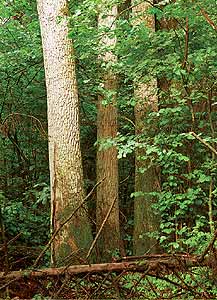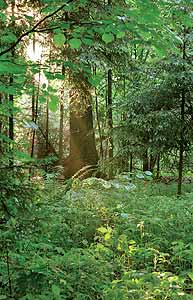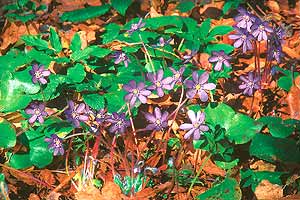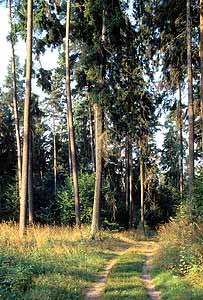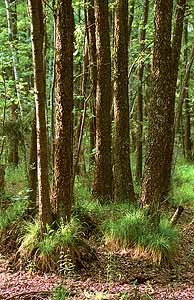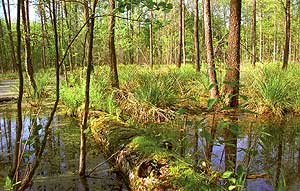|
FORESTS
|
|||||||||||||
Text
|
Types of forest communities
In the forests of the Wigry National Park (WNP), the most common plant communities are oak-hornbeam woods. Typical oak-hornbeam woods are multi-species and multi-storey deciduous forests occurring on fertile clayey soils. In the top storey, common oak (Quercus robur) and linden (Tilia cordata) dominate, with only the tops of huge spruces (Picea abies) above them. In the lower storeys, the major role is played by common maple (Acer platanoides). Less numerous are: common silver birch (Betula pendula), goat willow (Salix caprea), aspen (Populus tremula), European ash (Fraxinus excelsior), wych elm (Ulmus glabra) and common elm (Ulmus minor).
Some 60% of the forested area of the Park is covered by the association of sub-continental oak-hornbeam wood (Tilio-Carpinetum). The species composition of oak-hornbeam associations is rich and variable. This variability has resulted from the economic activities of Man. For several decades, valuable deciduous species have been felled in the forests surrounding Lake Wigry. Since the 19th century, the practice of regenerating forest by introducing pines has become widespread. This entailed also an increase in the proportion of spruces which were easily established on clearings and under the light-penetrated canopy of pines. As a result, truncated oak-hornbeam wood associations appeared. The proportion of Scots pine (Pinus silvestris) should not usually exceed 30%, in the driest and poorest parts of oak-hornbeam woods. At present, the pine dominates (dominant species is the one which has the highest proportion in the number of trees in a tree stand) in the prevailing part of the forest stands of the Park. But this could often be misleading. The abundant occurrence of the pine, particularly in younger parts of the forests could indicate that we have to deal with poorer (i.e. coniferous) forest communities. It is only the careful viewing of the understorey (understorey is the lower layer of a forest stand, made of shrub and tree species) and herb layers which can reassure that we still have the oak-hornbeam wood association in a given site.
Among the shrubs there are: hazel (Corylus avellana), spindletrees – European (Evonymus europaeus) and verrucose (E. verrucosus), occurring particularly often, because it is a continental species), fly honeysuckle (Lonicera xylosteum) and young lindens, maples and oaks. In the herb layer, hepatica (Hepatica nobilis), wood anemone (Anemone nemorosa), greater stichwort (Stellaria holostea), wood cow-wheat (Melampyrum nemorosum) and Scotch mist (Galium silvaticum) can be found, among other species.
The pine is progressively phased out of the oak-hornbeam woods of the WNP. Deciduous species, both from spontaneous seeding or those planted manually, overshadow the bottom layer of the forest, and prevent the growth of photophilous (light-loving) pine seedlings, which eventually die. In the oak-hornbeam woods of the Park there is a surprisingly low proportion of hornbeam (Carpinus betulus). In this type of woods it is usually the most numerous species, while around Lake Wigry, the hornbeam occurs sporadically and only in small patches. Another characteristic feature of oak-hornbeam woods in the Park is the high proportion of spruce. In the moss variety of the sub-continental oak-hornbeam wood this proportion can even reach up to 60%.
Also essential in forests of the WNP is the proportion of associations classified in the mixed coniferous forests class. The mixed coniferous forests are associations less rich than oak-hornbeam woods. The most abundant in the Park than oak-hornbeam woods. The most abundant in the Park is the association of sub-boreal mixed coniferous forest (Serratulo-Pinetum), covering nearly 30% of the forested areas.
In this light-penetrated community, the dominant species is Scots pine, whose proportion in the driest sites can even reach up to 90%. Apart from pine, there are variable proportions of spruce. Other species in these stands are: common oak, verrucose birch and aspen. The shrub layer is well-developed in mixed coniferous forests (although not that rich as in oak hornbeam woods) made principally of hazel (Corylus avellana), alder buckthorn (Frangula alnus), rowan (Sorbus aucuparia), guelder rose (Viburnum opulus) and hawthorns (Crataegus).
On markedly smaller areas of the WNP, there are forest associations on humid or water-logged soils. Among these, alder carrs and riverine carrs dominate, which combined cover nearly 5% of all forested areas of the Park. Alder carrs are bog forests made of common alder (Alnus glutinosa). They have a distinct appearance with small hillocks surrounding tree trunks. These hillocks are formed as a result of changeable levels of the groundwater . Depressions between the hillocks could remain filled with water for significant periods every year. In the tree layer, the alder is accompanied by ash (Fraxinus excelsior), downy birch (Betula pubescens) and by spruce which is ubiquitous in the Park’s forests.
Riverine carrs emerge in all places where water infiltrates or on periodically water-logged sites, mainly in river valleys. They do not have the hillock structure and the tree species composition is richer there than in alder carrs. Apart from alders, ashes, birches and spruces, there are also oaks, lindens and maples as well as elms. The understorey is well developed and consists mainly of young trees.
The remaining area of the Park’s forests (ca. 5%) is covered by pine or pine-spruce coniferous forests associations. The largest patches of these forests are in the southern part of the Park because they occur on the poorest, sandy soils.
|
||||||||||||
|
|
|
